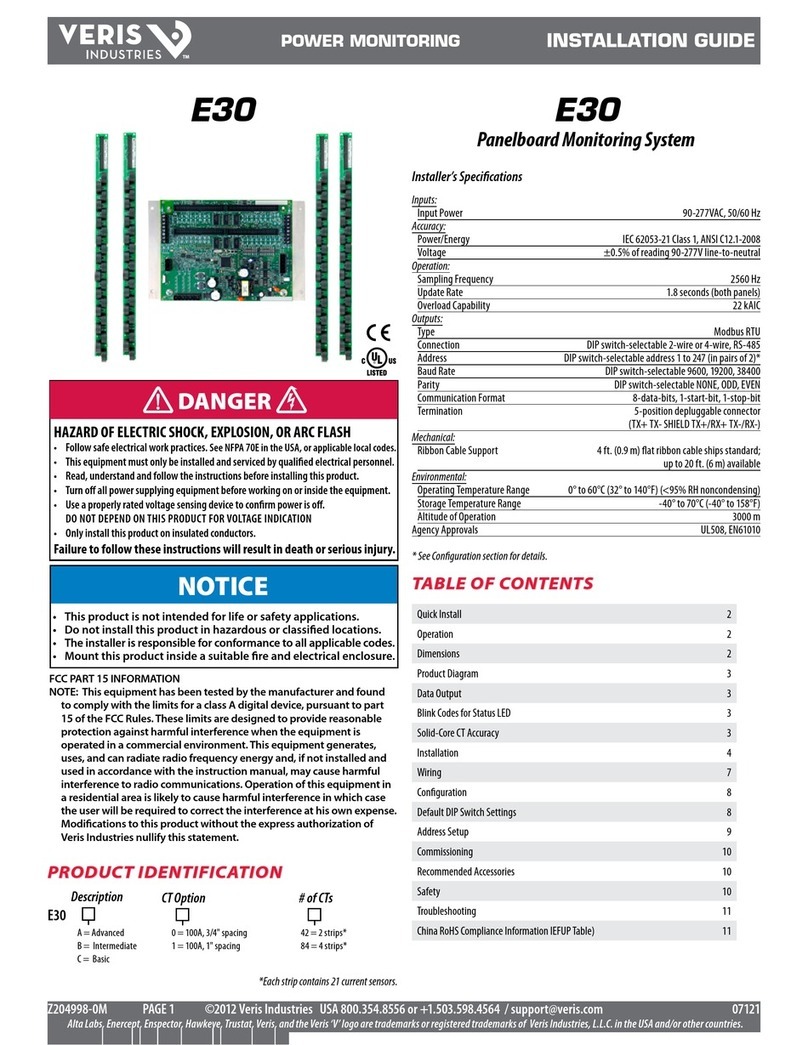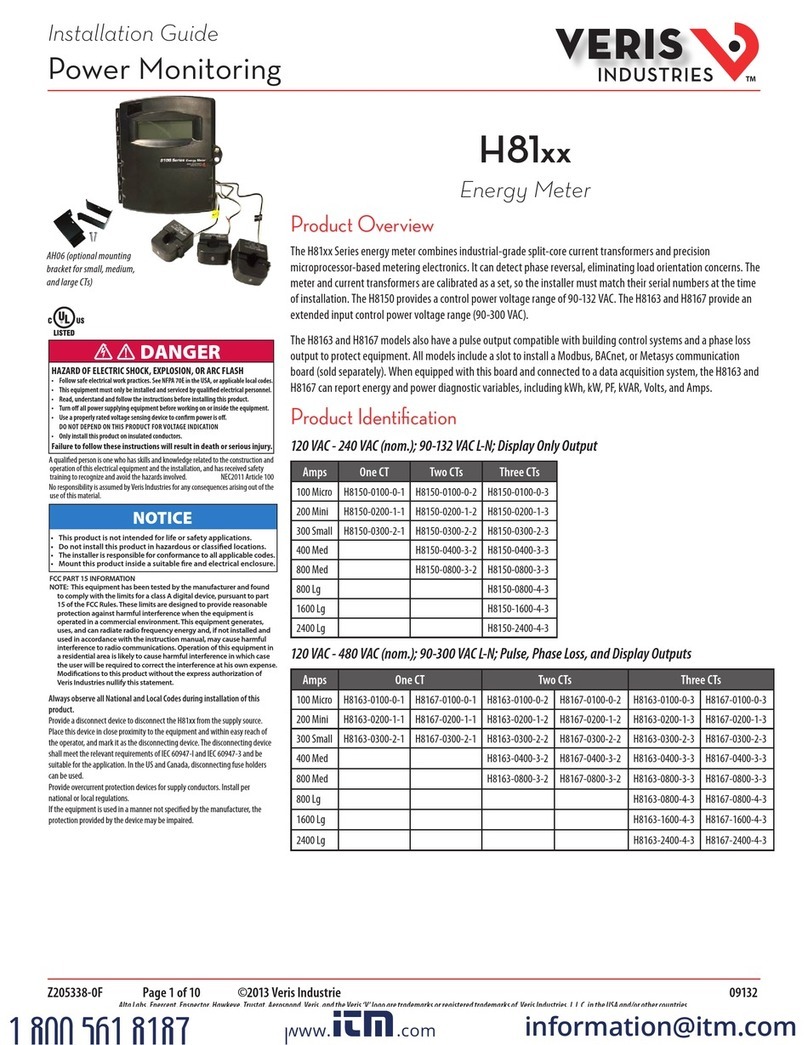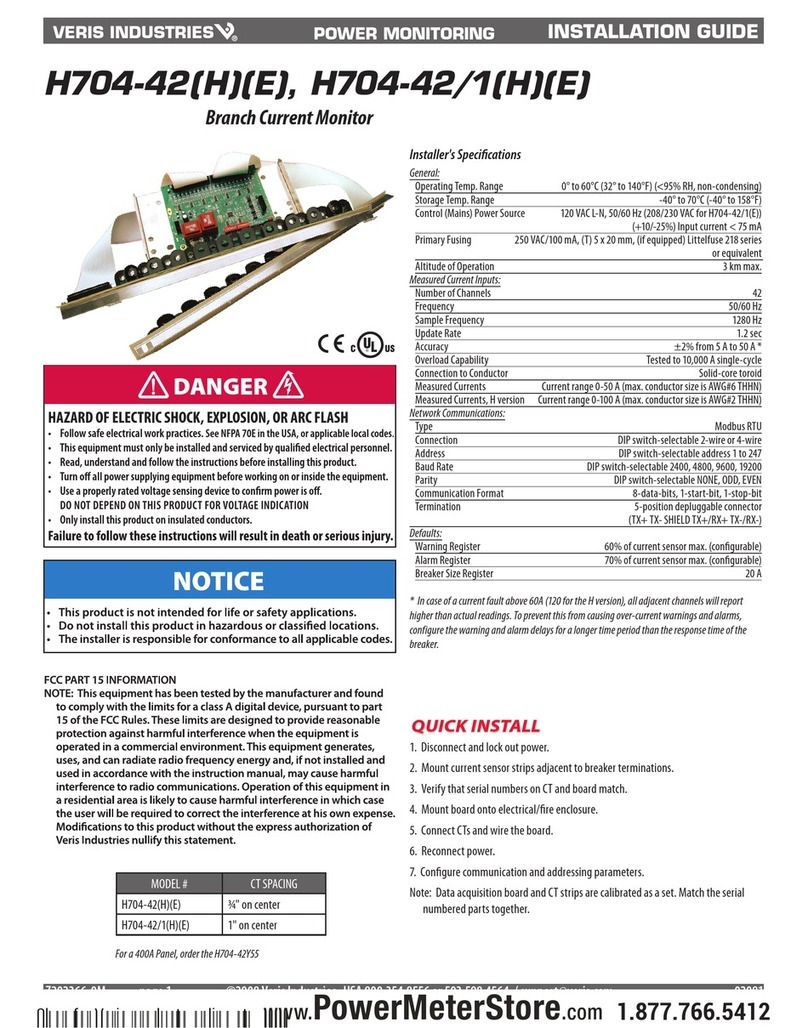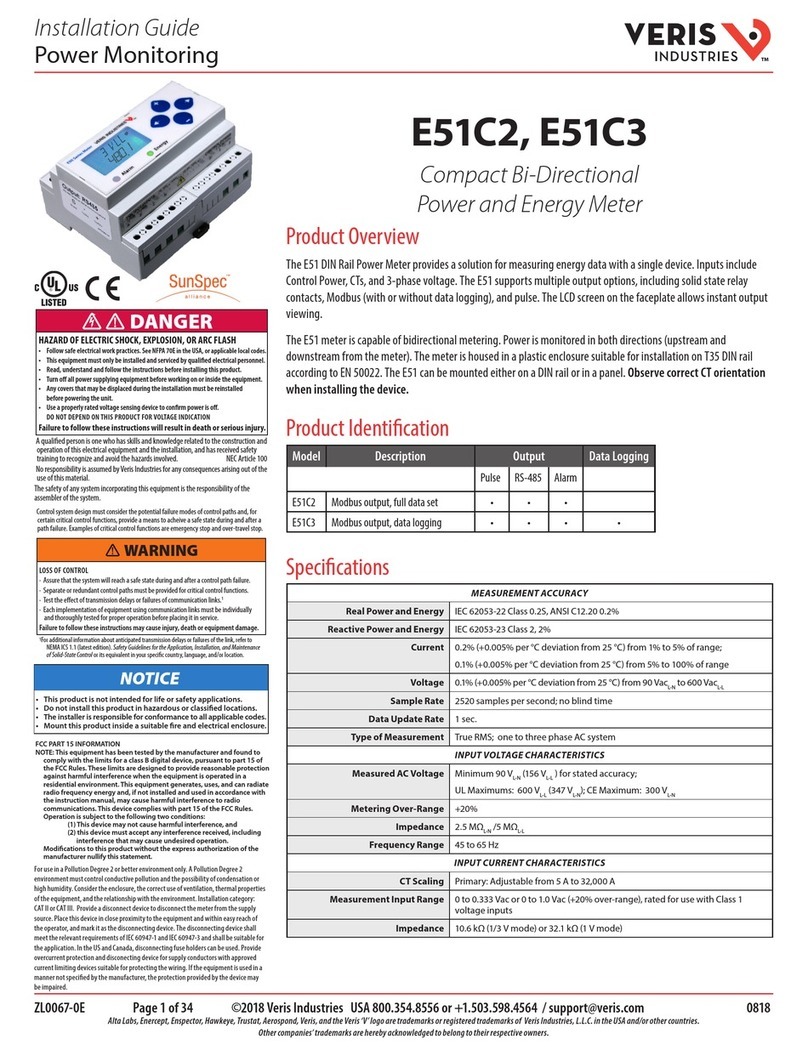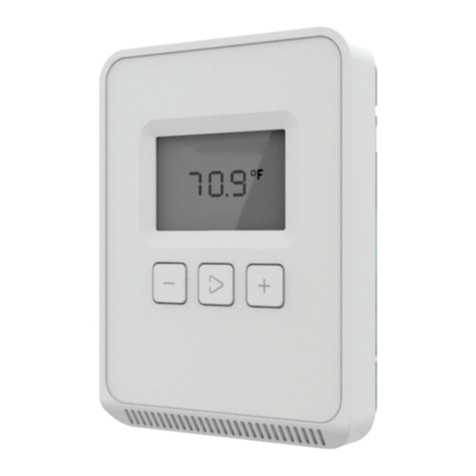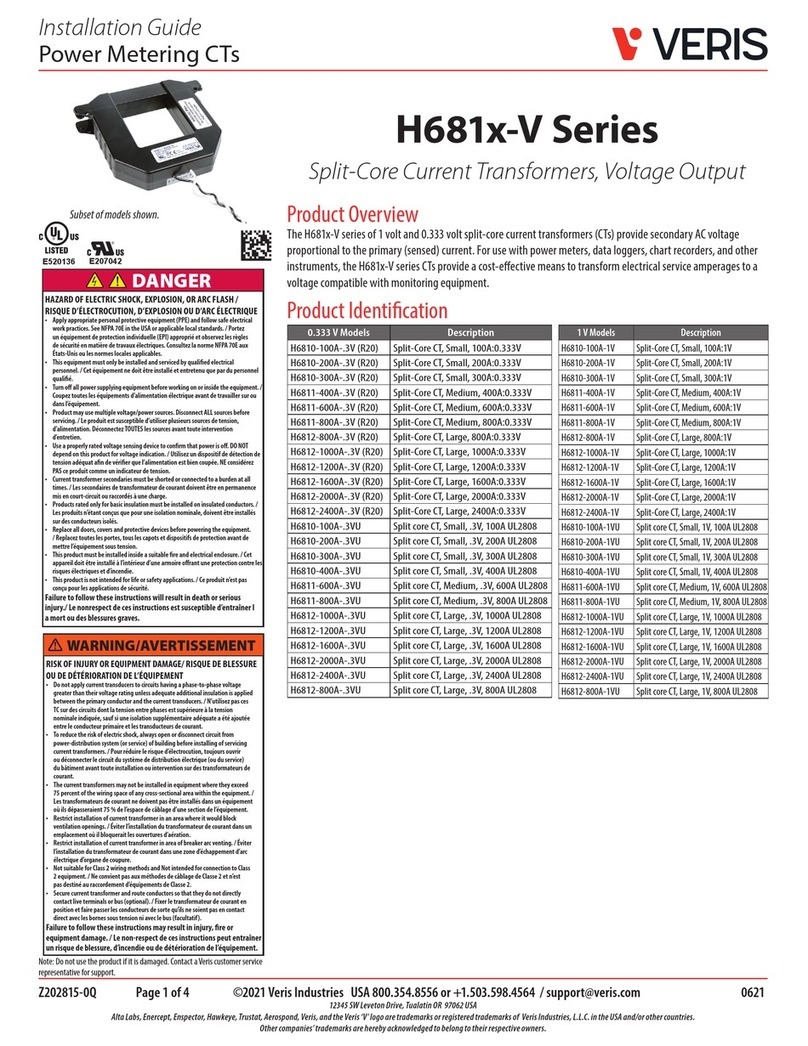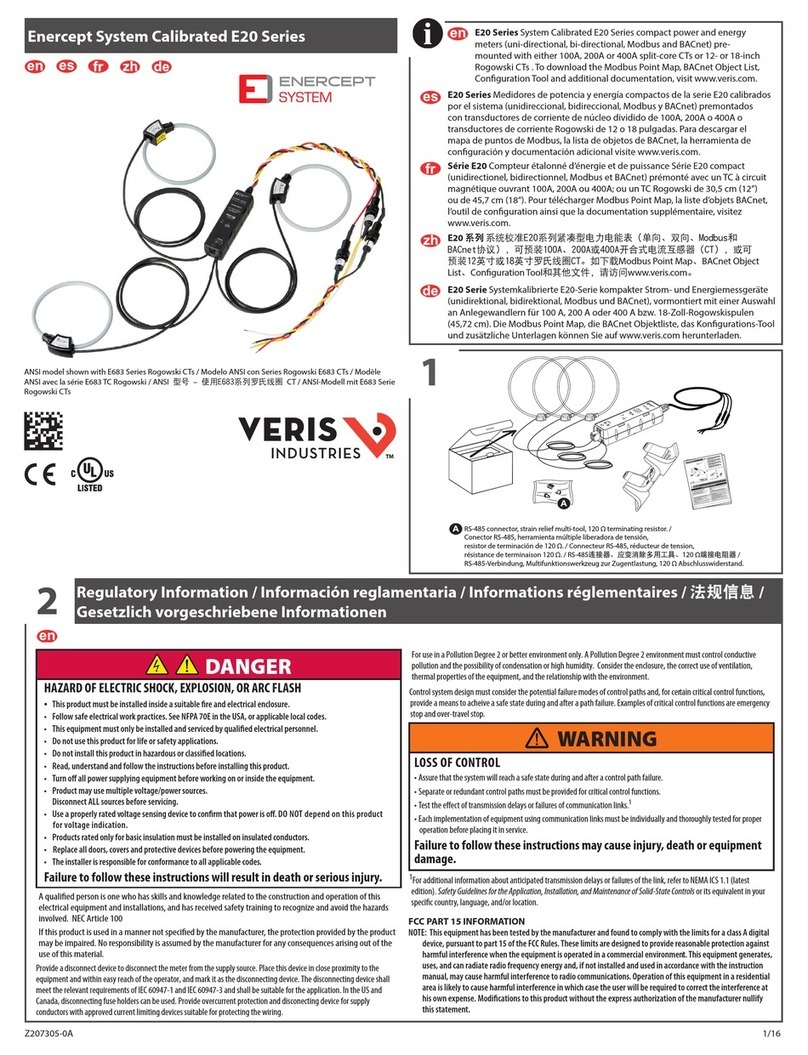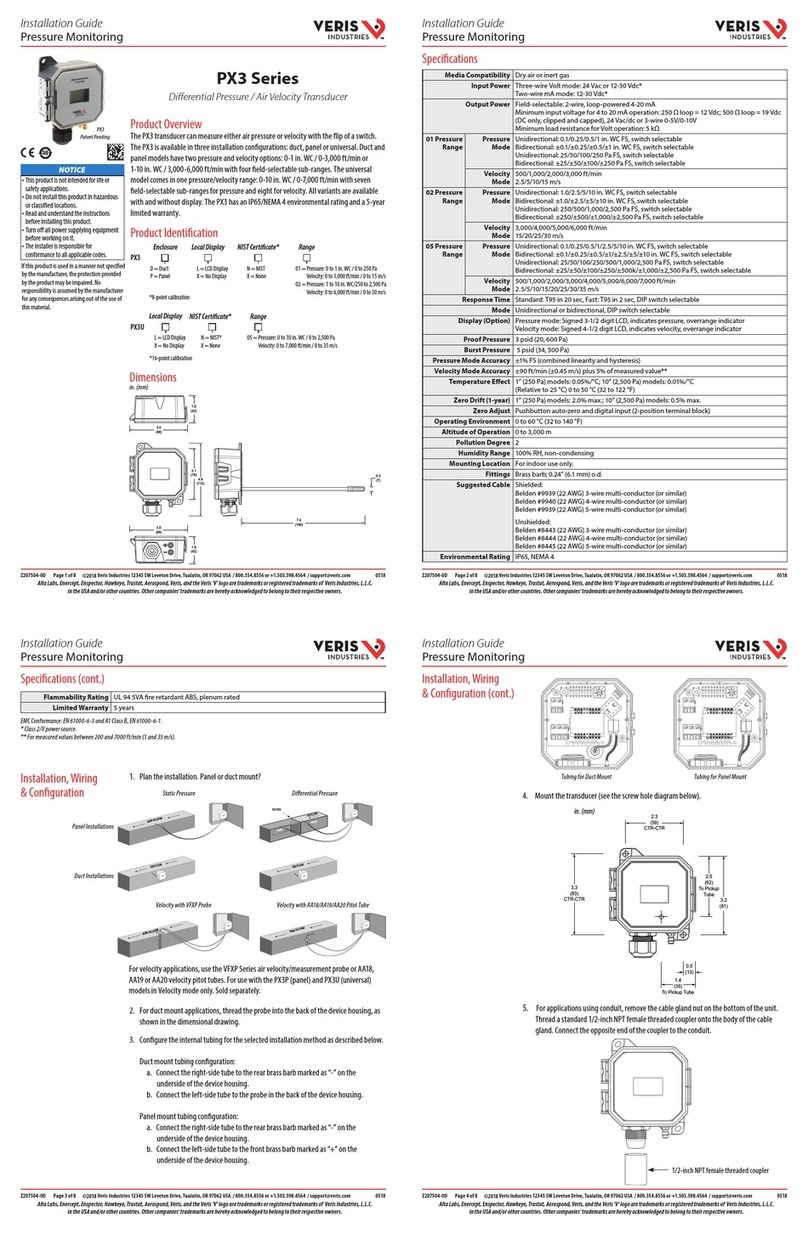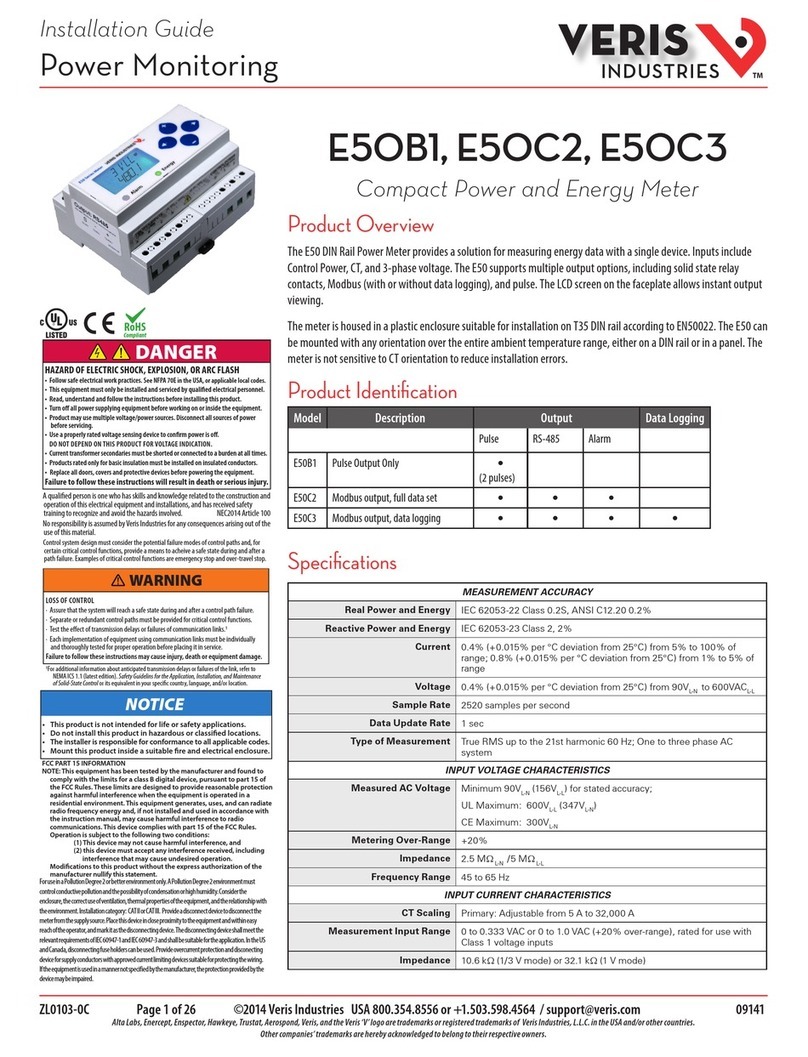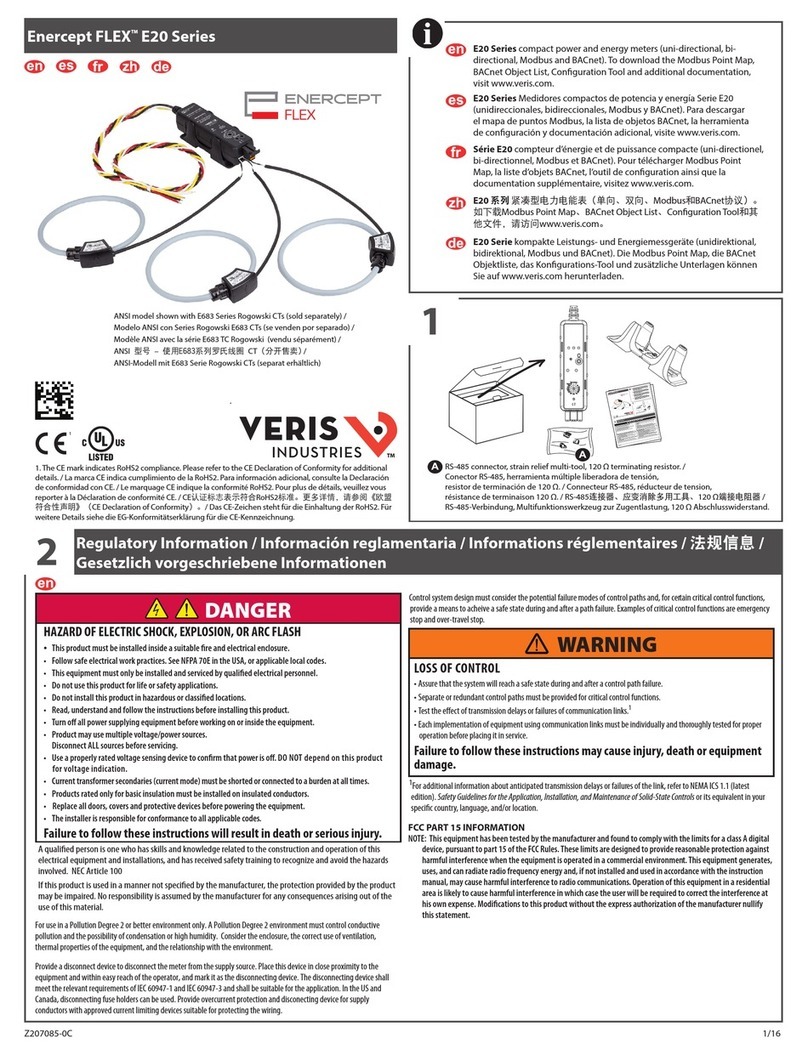Installation Guide
Power Monitoring TM
Installation Guide
Power Monitoring
E61C20 TM
HAZARD OF ELECTRIC SHOCK, EXPLOSION, OR ARC FLASH
• Follow safe electrical work practices. See NFPA 70E in the USA, or applicable local codes.
• This equipment must only be installed and serviced by qualified electrical personnel.
• Read, understand and follow the instructions before installing this product.
• Turn off all power supplying equipment beforeworking on or inside the equipment.
• Product may use multiple voltage/power sources. Disconnect ALL sources before
servicing.
• Use a properly rated voltage sensing device to confirm thatpower is off.
DO NOT DEPEND ON THIS PRODUCT FOR VOLTAGE INDICATION.
• Current transformer secondaries must be shorted or connected to a burden at all times.
• Products rated only for basic insulation must be installed on insulated conductors.
• Replace all doors, covers and protective devices before powering the equipment.
Failure to follow these instructions will result in death or serious injury.
A qualied person is one who has skills and knowledge related to the construction and
operation of this electrical equipment and installations, and has received safety
training to recognize and avoid the hazards involved. NEC Article 100
No responsibility is assumed by Veris Industries for any consequences arising out of the
use of this material.
DANGER
For us e in a Pollut ion Degr ee 2 or bet ter envir onment o nly. A Pollut ion Deg ree 2 envir onment
must controlconduc tivepollution and the possibilityof condensation or high humidity.
Consider theenclosure, the correct use of ventilation,thermal properties of the equipment,
and the r elatio nship wit h the envi ronmen t. Insta llation c ategor y: CAT II or CAT III. Pro vide
a disco nnect d evice to d isconne ct the me ter fro m the supp ly source . Place thi s device in
clos e proxim ity to the e quipme nt and wit hin easy r each of th e operat or, and mark i t as the
disconnecting device. Thedisconnec tingdevice shall meet therelevant requirements of
IEC 60 947-1an d IEC 60947-3 an d shall be su itable f or the app licati on. In the US a nd Canada ,
disconnecting fuse holders canbe used. Provide overcurrentprotec tionand disconecting
devic e for supp ly condu ctors w ith appr oved cur rent lim iting de vices sui table f or protec ting th e
wiring. Ift heequipment is used in amanner not specified byt hemanufac turer, the protection
provi ded by the d evice may b e impair ed.
NOTICE
• This product is not intended for life or safety applications.
• Do not install this product in hazardous or classied locations.
• The installer is responsible for conformance to all applicable codes.
• Mount this product inside a suitable re and electrical enclosure.
FCC PART 15 INFORMATION
NOTE: This equipment has been tested by the manufacturer and found to
comply with the limits for a class B digital device, pursuant to part 15 of
radio frequency energy and, if not installed and used in accordance with
the instruction manual, may cause harmful interference to radio
communications. This device complies with part 15 of the FCC Rules.
Operation is subject to the following two conditions:
(1) This device may not cause harmful interference, and
(2) this device must accept any interference received, including
interference that may cause undesired operation.
Modifications to this product without the express authorization of the
manufacturer nullify this statement.
WARNING
LOSS OF CONTROL
∙ Assure that the system will reach a safe state during and after a control path failure.
∙ Separate or redundant control pathsmust be provided for critical control functions.
∙ Test the eect of transmission delays or failuresof communication links.1
∙ Each implementation of equipment using communication links must be individually
and thoroughly tested for proper operation beforeplacing it in ser vice.
Failure to follow these instructions may cause injury, deathor equipment damage.
1For additional information about anticipated transmission delaysor failures of the link, refer to
NEMA ICS 1.1 (latest edition). Safety Guidelins for the Application, Installation, and Maintenance
of Solid-State Control or its equivalentin your specic country, language, and/or location.
Control system design must consider the potential failuremodes of control paths and, for
certain critical control functions, provide a means to acheive a safe state during and after a
path failure. Examples of critical control functions are emergency stop and over-travel stop.
Product Overview
The E61C20 panel mount power and energy meter provides basic four quadrant metering capability with
Modbus communication via ethernet cable. It includes voltage and current inputs, optically isolated digital
inputs and outputs, and a multi-tariff feature for accumulated energy readings. The E61C20 requires external
power to operate.
E61C20
Power and Energy Meter
Specifications
CONTROL POWER
AC 100-277 VACL-N ± 10%; 100- 415 VACL-L ± 10%
DC 125-250 VDC ± 20%
AC Burden 5 W/11 VA max. at 415 VAC
DC Burden 4 W max. at 125 VDC
Frequency 50/60 Hz ± 5 Hz
Fuses 500 mA
Wire Size 0.82 - 3.31 mm2(18 - 12 AWG)
Terminal Block Torque 0.5 - 0.6 N·m (4.4 - 5.3 in·lb)
VOLTAGE INPUTS
Measured Voltage UL CAT III, 20-347VL- N /35-600VL-L (Delta)
IEC CAT III, 20 -400VL- N /35-690VL-L
Frequency 50/60 Hz
Impedance 5 MΩ
Wire Size 0.82 - 3.31 mm2(18 - 12 AWG)
Terminal Block Torque 0.5 - 0.6 N·m (4.4 - 5.3 in·lb)
CURRENT INPUTS
Nominal Current 1 A or 5 A (Note: 1A accuracy is from 150mA only)
Measured Current 5 mA to 8.5 A
Withstand 20 A continuous; 50 A@10 sec/hr; 500 A@1 sec/hr
Frequency 50/60 Hz
Impedance <0.3 mΩ
Burden <0.026 VA@8.5 A
Wire Size 0.82 - 3.31 mm2(18 - 12 AWG)
Terminal Block Torque 0.9 - 1.0 N·m (8.0 - 9.0 in·lb)
DIGITAL OUTPUT
Maximum Load Voltage 40 VDC
Maximum Load Current 20 mA
On Resistance 50 Ω max.
Pulse Width 50% duty cycle
Pulse Frequency 25 Hz max.
Leakage Current 0.03 µA
Isolation 5 kV RMS
LED OPTICAL OUTPUT
Pulse Width (orange LED) 200 µsec
Pulse Frequency 50 Hz max.
COMMUNICATION
Ethernet Port 10/100 Mbps; Modbus TCP/IP; 1 port
Specifications (cont.) MEASUREMENT ACCURACY
Accuracy IEC 61557-12 PMD/[SD|SS]/K70/0.5
Real Power and Energy Class 0.5 as per IEC 61557-12; Class 0.5S as per IEC 62053-22
Reactive Power and Energy Class 2 as per IEC 61557-12; Class 2S as per IEC 62053-23
Current, Phase Class 0.5 as per IEC 61557-12
Voltage, L -N Class 0.5 as per IEC 61557-12
OPERATING CONDITIONS
Operating Temperature
and Humidity Range
-25°C to 70°C (-13° to 158°F) (5% to 95% RH noncondensing)
(display functions to -25°C with reduced performance)
Storage Temperature Range -40° to 85°C (-40° to 185°F)
Altitude of Operation < 2000 m
COMPLIANCE INFORMATION
Approvals CE I EC61010 -1 Ed-3; UL61010 -1; IEC 61010 -1; IEC62052-11;
IEC 61557-12
Housing Pollution Degree 2, Installation Category III
Not suitable for wet locations. For indoor use only.
ZL0142-0B Page 1 of 6 ©2014 Veris Industries USA 800.354.8556 or +1.503.598.4564 / support@veris.com 1214
Alta Lab s, Enercept, Enspector, Hawkeye , Trustat, Aerospond, Ver is, and the Veris ‘ V’ logo are t rademarks o r registere d trademark s of Veris Ind ustries, L.L .C. in the USA and/or other co untries.
Other companies’ trademarks are hereby acknowledged to belong to their respective owners.
ZL0142-0B Page 2 of 6 ©2014 Veris Industries USA 800.354.8556 or +1.503.598.4564 / support@veris.com 1214
Alta Lab s, Enercept, Enspector, Hawkeye , Trustat, Aerospond, Ver is, and the Veris ‘ V’ logo are t rademarks o r registere d trademark s of Veris Industrie s, L.L.C. in the USA and/or o ther countries.
Other companies’ trademarks are hereby acknowledged to belong to their respective owners.
Dimensions
3.8”
(96 mm)
3.8”
(96 mm)
4.2”
(108 mm)
3.6”
(91 mm)
0.5”
(13 mm) 3.1”
(79 mm)
2.8”
(72 mm)
Product Diagram
A. Menu selection buttons
B. LED indicators (orange and green)
Orange is programmable for either alarm or
energy pulse
Green indicates meter heartbeat/communications
C. Navigation or menu selections
▲ Exit screen and go up one level
▲ Move cursor up the list of options
▼ Move cursor down and display more options
▲
Move cursor one character to the left
▲
Scroll right and display more menu items
E F
GH
I
J
A
B
C
D
K
+Show the next item in the list, or increase the highlighted value
–Show the previous item in the list
D. Maintenance and alarm notification area
E. Voltage inputs
F. Control power
G. Current inputs
H. Status inputs/digital outputs
I. Ethernet communication port
J. Gasket
K. Latching points
